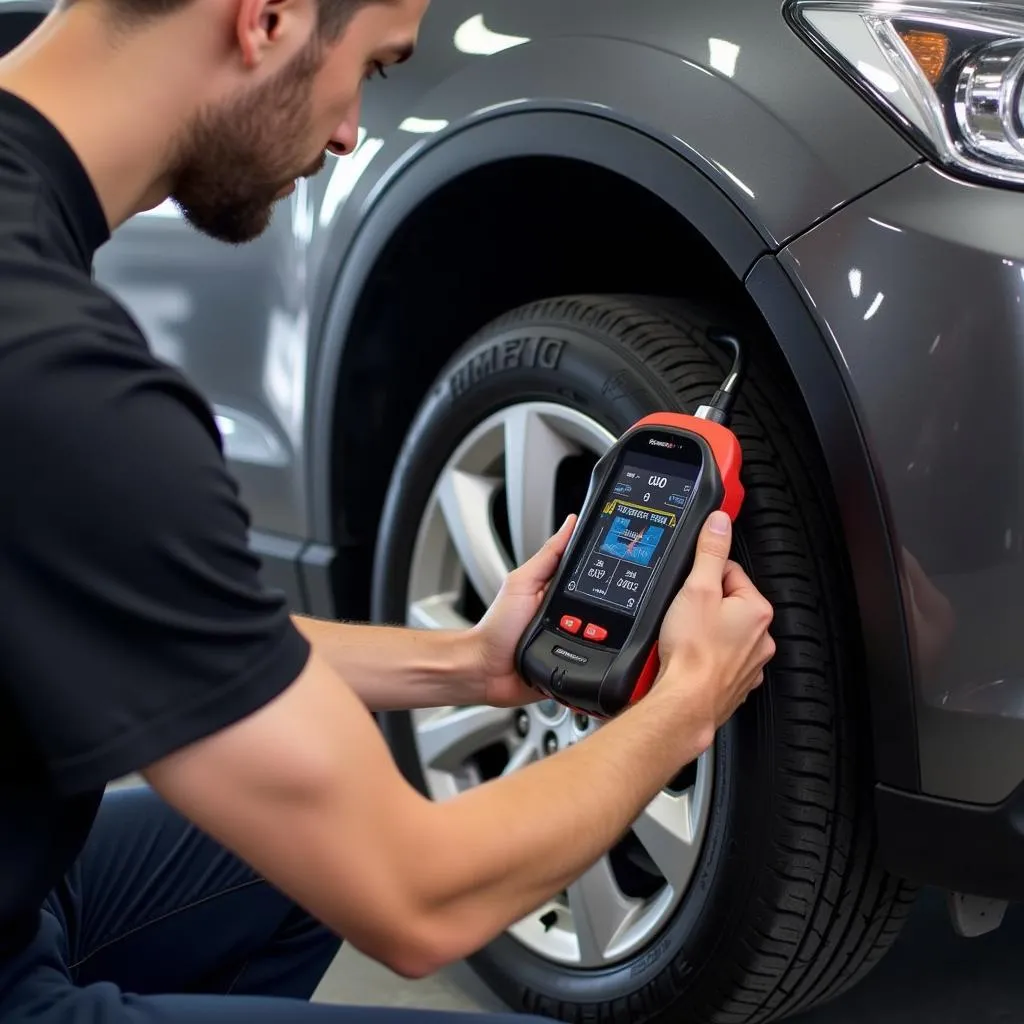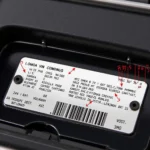A TPMS tester, short for Tire Pressure Monitoring System tester, is an essential tool for any mechanic or car enthusiast who performs their own maintenance. This guide dives deep into the world of TPMS, exploring its functionality, the different types of systems, and how to use a TPMS tester effectively.
What is a TPMS Tester & Why Do You Need One?
Imagine this: you’re driving down the highway, and suddenly, your tire pressure warning light flashes on. This warning, triggered by your car’s TPMS, could indicate a slow leak or a potentially dangerous tire blowout waiting to happen. A TPMS tester helps you address this situation head-on.
In essence, a TPMS tester is a specialized device that allows you to:
- Read TPMS Sensor Data: The tester communicates with the sensors within your tires, providing you with crucial information like tire pressure, sensor ID, and battery life.
- Diagnose TPMS Issues: By reading the sensor data, you can identify problems such as malfunctioning sensors, weak batteries, or signal interference.
- Program New TPMS Sensors: When replacing tires or sensors, a TPMS tester lets you program new sensors to your car, ensuring the TPMS system recognizes them.
Without a TPMS tester, diagnosing and resolving TPMS issues can be a guessing game, potentially costing you time, money, and even compromising your safety.
Types of TPMS Systems: Direct vs. Indirect
Before we delve into the specifics of TPMS testers, it’s important to understand the two main types of TPMS systems used in vehicles:
1. Direct TPMS:
- How it works: Employs pressure sensors located within each tire, directly measuring pressure.
- Accuracy: Offers higher accuracy as it provides real-time pressure readings from each tire.
- Features: May include additional data points like tire temperature.
2. Indirect TPMS:
- How it works: Relies on the vehicle’s ABS (Anti-lock Braking System) to monitor tire rotational speed. If a tire is low on pressure, it will rotate at a different speed, triggering the warning light.
- Accuracy: Less accurate compared to direct TPMS, as it infers pressure indirectly.
- Cost: Generally, more affordable than direct TPMS.
The type of TPMS your vehicle uses will determine the type of TPMS tester you need. Some testers are compatible with both systems, while others are designed specifically for one or the other.
Choosing the Right TPMS Tester: Features to Consider
Not all TPMS testers are created equal. When selecting a tester, consider these key features:
- Vehicle Coverage: Ensure the tester is compatible with your car’s make, model, and year. Some testers offer wider vehicle coverage than others.
- Functionality: Determine what you need the tester to do. Basic testers read sensor data, while more advanced models can program sensors, perform OBDII diagnostics, and provide more comprehensive information.
- Ease of Use: Look for testers with intuitive interfaces, clear displays, and easy-to-understand menus.
- Durability: Since TPMS testers are frequently used in garages and workshops, opt for a durable and well-built device that can withstand regular use.
- Additional Features: Some testers offer extra features like Bluetooth connectivity, allowing you to transfer data to a smartphone or computer.
Using a TPMS Tester: A Step-by-Step Guide
Once you’ve chosen the right tester, using it is a straightforward process:
1. Gather Your Tools: TPMS Tester, tire pressure gauge (for verification)
2. Park Your Vehicle: Ensure the vehicle is parked on a level surface and the parking brake is engaged.
3. Access the Sensors: Depending on the tester model, you may need to remove the valve cap to access the sensor.
4. Activate the Tester: Power on the TPMS tester and follow the on-screen instructions to select your vehicle’s make, model, and year.
5. Read Sensor Data: Hold the tester near the tire valve stem to read the sensor data, which typically includes tire pressure, sensor ID, and battery life.
6. Verify Readings (Optional): Use a tire pressure gauge to cross-check the pressure readings provided by the tester.
7. Program New Sensors (If Needed): If replacing sensors, follow the tester’s instructions to program the new sensors to your vehicle.
8. Re-learn Sensors (If Needed): After installing new sensors or rotating tires, you may need to perform a TPMS relearn procedure. Consult your vehicle owner’s manual for specific instructions.
Benefits of Using a TPMS Tester: Safety, Efficiency, & More
Investing in a TPMS tester offers numerous benefits:
- Enhanced Safety: By accurately monitoring tire pressure, you can identify and address potential issues before they escalate into dangerous situations.
- Improved Fuel Efficiency: Properly inflated tires reduce rolling resistance, leading to better fuel economy.
- Extended Tire Life: Driving with underinflated tires can cause uneven wear and tear, shortening their lifespan. A TPMS tester helps ensure proper inflation, extending tire life.
- Cost Savings: Addressing tire issues early can save you money on costly repairs or tire replacements down the line.
- DIY Empowerment: A TPMS tester empowers you to take control of your vehicle maintenance, saving you trips to the mechanic for simple tire-related tasks.
TPMS Testers: An Indispensable Tool for Today’s Cars
As technology advances and TPMS systems become increasingly sophisticated, TPMS testers are no longer a luxury but a necessity for any mechanic or car owner who wants to stay ahead of the curve. By understanding the intricacies of TPMS and choosing the right tester, you can ensure the safety, efficiency, and longevity of your vehicle’s tires.
Frequently Asked Questions about TPMS Testers:
1. Can I use a regular tire pressure gauge instead of a TPMS tester?
While a regular gauge can check tire pressure, it cannot read sensor data, program new sensors, or diagnose TPMS issues.
2. How often should I check my tire pressure?
It’s recommended to check your tire pressure at least once a month, and before long trips.
3. What does the TPMS warning light look like?
It’s typically an exclamation mark inside a tire-shaped symbol, often yellow or orange.
4. Can I program new TPMS sensors myself?
Yes, with the right TPMS tester and by following the instructions, you can program new sensors yourself.
5. What happens if my TPMS sensor battery dies?
The TPMS warning light will illuminate on your dashboard, indicating a sensor needs replacement.
Still have questions about auto tester tool?
We’re here to help! Contact us via WhatsApp: +1(641)206-8880, Email: [email protected] or visit us at 276 Reock St, City of Orange, NJ 07050, United States. Our dedicated team is available 24/7 to assist you.



